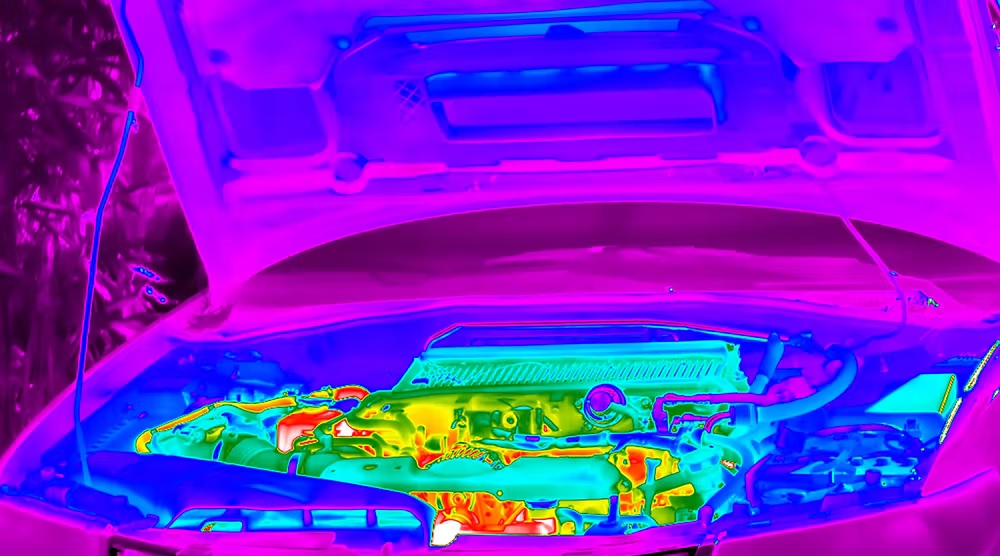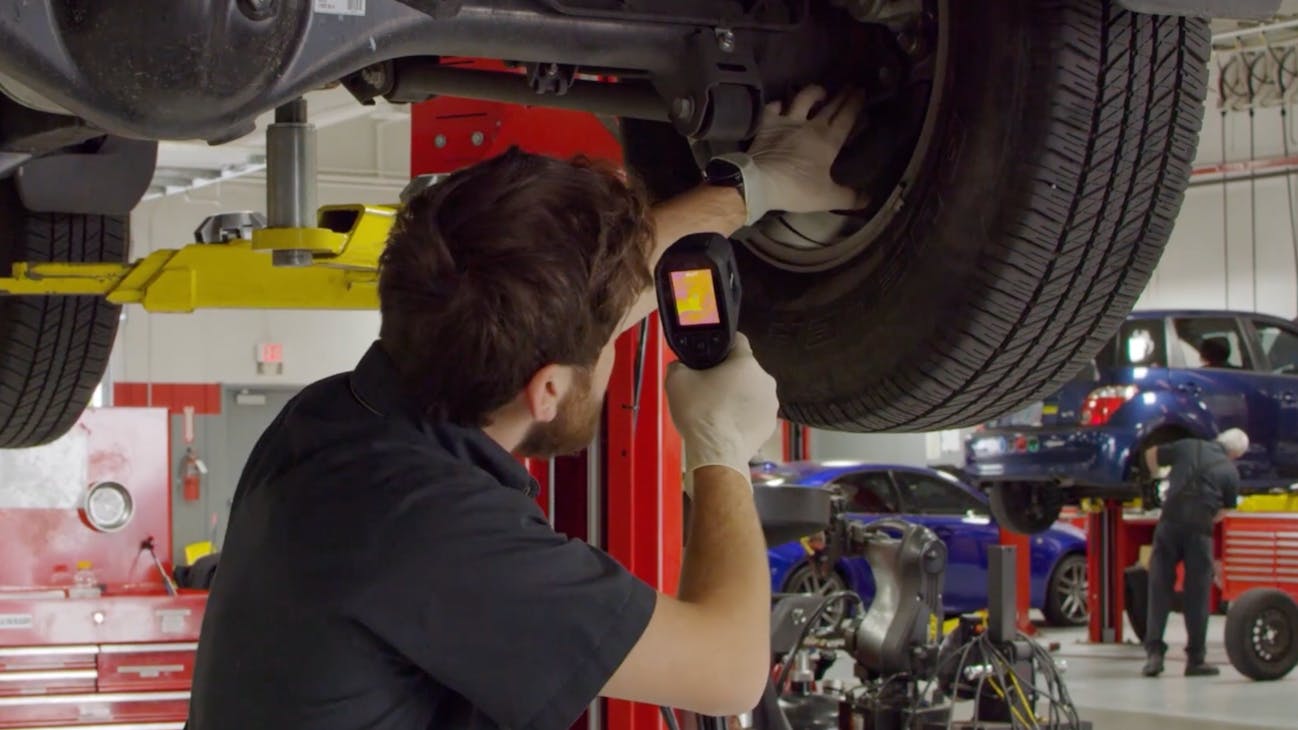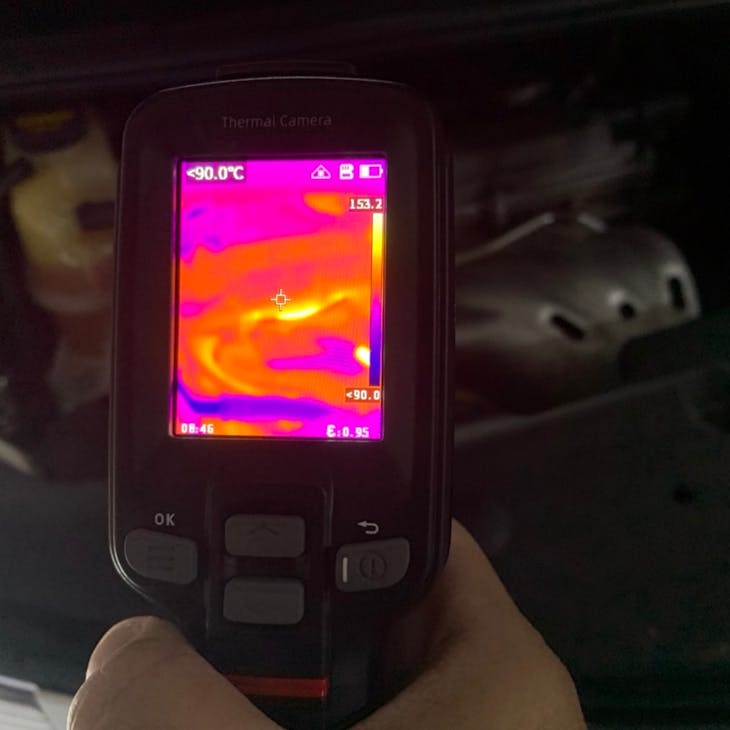The use cases for thermal imaging are abundant, and their integration into maintenance operations can provide expediency, efficiency, and transparency for all parties involved.
Though they are not prevalent in today’s shop, thermal imaging cameras have proven an effective, non-invasive method of inspection and evaluation for vehicle components. By using infrared light to measure variations in temperature, these devices allow technicians to immediately determine if further work needs to be conducted—ultimately speeding up the repair process.
Other benefits of thermal image inspection include assisting in diagnostics, helping pinpoint trouble areas and defects, presenting status reports on systems, and even creating transparency and providing verification throughout the repair process.
“I see this technology becoming as commonplace at some point as the handheld temperature sensors,” said Talon Thomas, product management technical engineer at Noregon Systems, of thermal imaging. Thomas previously served as a technician and believes thermal imaging cameras will one day become the go-to temperature scanner and possibly replace other diagnostic methods.
Currently, thermal cameras can be costly, and technicians can use other tools and techniques to provide the same results. So, are they worth it?
“It can be one of those tools that just sits around in the shop,” Thomas said, “but, when you need it, it becomes very useful.”
Thermal imaging cameras reveal differences in temperature, displayed as different colors on the spectrum, with red being hotter and blue colder.
“These cameras display hot and cold temperatures as colors, so you can easily troubleshoot issues related to heated seats, catalytic converters, drivetrain components, and much more,” explained Michael Fisher, product manager, K-Tool International. “They provide a quick visual inspection to see if there is more labor involved and if your intuitions are correct, as well as eliminate unnecessary steps when trying to find a problem with a vehicle.”
Thomas believes the vehicle repair industry will realize the technology’s usefulness as it becomes more accessible.
“It will happen because the price point started coming down to where technicians can afford it as part of their toolkits versus something only shops could afford,” he said.
Teledyne FLIR is one manufacturer trying to increase overall adoption of thermal imagers. The company provides cameras for the military and emergency response, with its sensor technology placed on everything from drones to smartphones. Automotive maintenance might not be as obvious a place to use infrared imaging as firefighting or a special ops mission, but there are plenty of reasons in the shop to use one.
“Operators can move from simply detecting to understanding specifically where a given problem is located,” said Chris Bainter, VP of business development and marketing for Teledyne FLIR. “Thermal cameras also allow for more discreet temperature measurement spots than spot pyrometers, which image a larger area and give an average measurement value”
Thermal imaging tools provide thousands of points of measurement in an easy-to-interpret image, while spot pyrometers only provide a single point of measurement.
“With a spot pyrometer, technicians must guess where the problem lies,” Bainter explained. “They risk missing smaller hot spots that could be indicative of a problem. Therefore, thermal imagers provide more actionable results that will improve productivity and accuracy while saving time and associated costs.”
Thomas attested that employing them for “specific use cases to go after a specific symptom” will improve thermal imagers’ usefulness.
“Good technicians that already have a good diagnostic skill set, without even telling them, would already know what the use cases could be,” he explained. “It is one more thing to make your life a little bit easier. You can actually see the problems instead of having to hunt and feel for them.”
Thermal inspection applications
Knowing how and when to use thermal cameras can boost ROI and speed up the diagnostic process. So, let’s assess the areas, systems, and components of a commercial vehicle that can benefit from the application of thermal imaging. That way, fleets can determine if these cameras will be a valuable tool each shop should have, or merely a cool gadget with limited applications.
Wheels, tires, and brakes
FLIR’s Bainter suggested that after a road test, technicians can inspect tires for irregular heating patterns. Heat spots could indicate variations in inflation, vehicle misalignment, or defects in the tire itself.
Inspecting brakes with thermal imagers can reveal issues, Fisher stated. “The thermographic load must spread evenly throughout the whole brake disc with no grooves or rings showing.”
Fisher suggested that techs measure the temperature of the driver-side brake followed by the passenger-side brake across the same axle and compare the results.
“The temperature should be within a few degrees of each other,” he said. “If they are 10, 20, 30 degrees off, there may be a brake fluid issue that needs to be addressed.”
An infrared camera will detect nuanced differences in temperature out of reach for a tech, such as around the caliper, which could indicate a mechanical failure.
“Stuck pistons may be causing one caliper to stick, causing abnormal wear and heat on one rotor,” Bainter pointed out. “The same might also be true for a stuck parking brake with a damaged cable. Both situations should be visible in thermal imaging due to the heat they generate.”
“If you have a brake chamber that is ruptured and it’s not working, or you have a slack adjuster that is seized, or the S-cam itself is seized, you can take the truck for a test drive, really romp on the brakes, and get them hot,” Noregon’s Thomas explained. “Then use the thermal imager to walk around the truck and see which wheel ends are hot versus which ones might be cool. The ones that are cool, you may have a braking system application problem there.”
Powertrain
In the engine, thermal cameras will also reveal abnormalities via higher or lower temperature ranges of specific components.
“Thermal cameras can highlight issues such as overheating,” Fisher said. “This could also help decide if there are internal issues without having to remove components for diagnosis.”
Cooler exhaust temperatures can reflect insufficient combustion, Fisher continued, indicating internal issues of the working conditions of the engine.
Exhaust system leaks, cracked manifolds, failed gaskets, and clogged catalytic converters can all be inspected through thermal imaging, which can pinpoint the locations of leaks and cracks, Bainter said.
A thermal imager can also aid in diagnosing failing injectors, as well as misfiring or low pressure in cylinders, Bainter continued. A suspected cylinder’s manifold will show a lower temperature than others through stark contrast across the cylinders.
“A thermal imager can reveal if a misalignment of pulleys is causing overheating and putting stress on the belt,” Bainter said of diagnosing a repeatedly failing accessory belt with thermal imagery.
Furthermore, thermal imaging can be used for validation of vehicle temperature sensors and readings.
Aftertreatment
“Especially as it relates to heavy-duty trucks’ DPF and SCR system temperatures, their temperatures are very important for normal regeneration system function and SCR system operation,” Thomas emphasized. “Regeneration validation is another thing; you can watch it ramp up and make sure that the DPF and the DOC are actually getting to temperature.”
Suspension and drivetrain
Temperature scans can reveal excessive friction from worn components, Bainter stated. Temperature differences in shocks across an axle can reveal if one (the cooler of the pair) is not operating to specification.
HVAC
A thermal imager is particularly useful for testing whether the air conditioning system is working properly, Bainter said.
“Initially, technicians can use a thermal camera to measure outlet temperature, compare outlets, and then determine if one is completely or partially blocked,” he continued. “They can also check surface temperatures of high- and low-pressure lines for damaged insulation. Meanwhile, failing thermostats, or clogged/blocked radiators or coolant lines, will be apparent when only part of a radiator shows it’s working properly, or a line has a sudden change in temperature at one spot along the hose where a blockage is located.”
“You can look directly at the line sets to know whether or not the compressor is pumping,” Thomas reinforced. “High pressurized refrigerant is hot. And so, you can see that contrast to the low side of the refrigerant line to verify that the compressor is pumping.”
“If you have an orifice or thermal expansion valve that is external from the evaporator core, you can watch the temperature drop across that orifice to judge whether or not the temperature of the refrigerant going into the evaporator core would be cool enough to perform well inside the cab in terms of cooling off the cab,” he continued. “If it’s not, you have an idea of where to start diagnosing things and potential places to look right off the bat without even pulling out any other tools yet.”
Cabin
Throughout a truck’s cab, thermal imaging cameras can be used for a scope of inspection points. Water that infiltrates the cab will evaporate and leave a ‘cold spot’ that can be detected and often lead technicians to tracing the source of a leak, Bainter said. Seats with heating/cooling systems can be inspected as they are exercised to reveal any failures. Rear window defrosters can be inspected across gridlines when activated, allowing technicians to diagnose and pinpoint any failures.
Furthermore, dashboard switchgear for components with a high current draw, such as accessory driving lights or heated seats, may carry abnormal resistance or shorting; if that is the case, they will heat up and as such, failing switches and/or relays can be spotted through thermal inspection.
Electrical
These devices provide a straightforward way to uncover apparent temperature differences in industrial three-phase electrical circuits compared to their normal operating conditions, Fisher explained. “By inspecting the thermal gradients of all three phases side by side, technicians can quickly spot performance anomalies on individual legs due to unbalance or overloading,” he said.
Fisher posed an example of cooling fans under the hood not shutting down; a thermal camera could be used on the cooling fans’ relays. If a relay is “glowing red,” it means that the relay position is stuck ‘open.’ This provides a quick inspection of the relays to target further diagnosis and repair.
Technicians can also use thermal imagers to uncover corroded wiring connections or fuses, Bainter pointed out, as such issues cause increased resistance and overheating. “Electrical tape, connectors, or wire loom might conceal these issues to the naked eye, but a thermal imager could pinpoint them easily,” he explained.
Thomas concurred that the application in chasing high resistance and loads throughout harnesses and connectors is an excellent use case for the technology.
“Anywhere you have high resistance, you start generating heat in wires or connectors,” he said. “With thermal imagery, you can see the temperature differential in a bundle of wires around the one that has higher temperature based on the loads running through it. You can trace down circuits and find out where the higher resistance may lie in the circuit.”
Batteries and electric vehicles
Though EVs do not have a combustion engine, heat is still generated throughout the vehicle, and that energy is dispersed in places like the battery pack, motors, and gearboxes, Thomas mentioned—all of which can be detected through thermal imagery. Take motor performance, for example.
“Even though these are brushless motors, many of them will not have a service interval for the bearings that support the heavy rotor,” Thomas said. “If they do seize up, you’ll lose efficiency and [experience] a lot more heat and power loss. Eventually, you’ll have component failure. At that point, the motor will start to almost destroy itself. It may be a good thing to look at components that may be wearing faster than others.” Thomas suggested getting under the vehicle after a test drive and using the thermal camera to inspect the motors, gearboxes, and axles for any excessive heat differences.
“That’s going to be very important with electric trucks—keeping the battery range,” he said. “If you have something that is pulling energy, such as a failed bearing, it is going to reduce mileage and overall range; at the same time, those components can be very expensive. You may want to catch it sooner than later before it decides to destroy itself.”
Thomas also offered thermal imaging cameras as an effective, non-invasive testing method for the high-voltage cables that are within the electric vehicle architecture. “You can’t really load-test the high-voltage cables with their insulation and the very high voltages,” he said. “You will have to resort to other means of testing insulation breakdown. There are industry standard practices for doing that, but when looking for high resistance in any of those cables, thermal imaging would absolutely help and be completely non-invasive.”
Any battery packs in series can be inspected through thermal imagery, Fisher said, as a dead pack within a series can easily be detected through temperature differences compared across the bank.
Refrigerated units
Thermal cameras can be used to inspect and diagnose aspects of a reefer trailer. Fisher noted components such as the reefer’s air driver system, wires, and connectors can be inspected to trace issues, as well as spotting leaks between panels on the trailer that could be causing a loss of temperature control.
“Go along the seams where they rivet the aluminum panels to a trailer to see if they’re properly assembled, or where there’s insulation in between, because that would be an exit point for the coolness or the heat to come in,” he suggested.
Confirming suspicions
Essentially, most any part, system, or component on a vehicle can be inspected by thermal imaging cameras. Because of the speed of such a tool, it is a great way to initiate the repair process. Did a vehicle roll into the bay with a suspected issue? Did the driver convey any suspicions or concerns with system performance? A thermal imaging camera can quickly be utilized to target such complaints and reveal a visual confirmation of performance inadequacy.
“Automotive maintenance and repair professionals need the right tools available to find and diagnose problems quickly—tools that can keep additional labor costs to a minimum,” Fisher emphasized. “With today’s complexity of automotive electrical and computer systems, many technicians are relying on high-tech equipment such as thermal imaging cameras and the latest test and measurement tools to ensure they can diagnose and perform the job to get it done quickly and efficiently. Thermal imaging cameras offer a reduction of unnecessary labor costs to locate problems and/or solutions.”
Using thermal imaging cameras can point out the issue area immediately, saving time before the task of deeper diagnosis and inspection.
Fisher related the issue of a dead cylinder. If a thermal camera quickly assesses that a single cylinder is cold compared to the rest, the shop already knows the subsequent work to be done. “You know how much it costs to tear down the engine and do the repair,” Fisher said. “You can bring this information to the customer and say, ‘Look. This is what is wrong with the vehicle. If you want me to go further, it is going to cost this much and take this long.’”
“More than anything, thermal imaging would go a long way toward helping validate customer concerns,” Thomas concurred. “Trucks don’t come into the shop for no reason; they usually come in with some sort of concern … Say the customer concern is that the truck is not doing a regen. You can use that technology to actually look at the temperature rise and increase in the aftertreatment system without even doing anything invasive, without even hooking up a service tool.”
Seeing the big picture
Another major benefit of thermal imaging is the ability to provide verification of repairs. Fisher related back to inspections of the braking system that resulted in different temperatures between rotors. Following a successful repair procedure, technicians could again inspect the system with the thermal imaging camera and provide visual results of the repair that verify success and indicate specified performance parameters. Another example he posed was inspection of a reefer trailer that previously had indicated a leak between panels. Following the repair, a clear image can be presented that any leaks have been sealed and the unit is operating as needed.
“It can be used as a ‘before and after,’” Thomas agreed. “Like when you get your car aligned and they show you the before and after printout. It is a similar opportunity to provide proof that you’ve successfully repaired something that was malfunctioning.”
Thomas also attested to the technology’s ability to aid in technician training. When training technicians on diagnostic procedures, having the ability to show visual cues and indicators can really drive home points of emphasis that can aid in retaining and understanding certain information.
“Being able to give them a picture without them having the feel for things gained through experience, you can say, ‘Here. This is what you’re looking for. This is what it looks like.’ And you can translate that to the feel for things.”
Source: https://www.fleetmaintenance.com/








